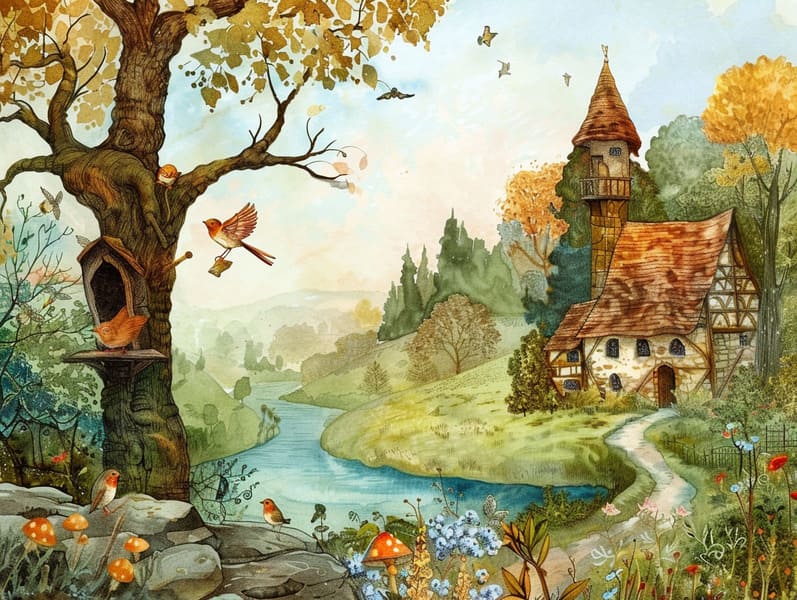Understanding the Legacy of Vintage Fairy Tales and Its Eternal Loveliness.
Understanding the Legacy of Vintage Fairy Tales and Its Eternal Loveliness.
Blog Article

Famous fairy tales have long histories. These stories have been spoken from one generation to the next centuries before they were ever documented. They came from a variety of backgrounds, including Asian traditions. They were initially told among older generations, often carrying themes and messages reflective of the societal norms and beliefs of the time.
The Grimm brothers, Jacob and Wilhelm (the Grimm brothers), were among the first to gather many of these beloved stories. Their published works, "Grimm's Fairy Tales," included tales like "The Story of Cinderella," "The Bread Crumb Trail," and "Little Snow White," which have since become classics in the world of children's fairy tales. Similarly, the Danish author's charming narratives, such as "The Mermaid," and "The Ugly Duckling," have gained the love worldwide, cementing their place in the pantheon of famous fairy tales.
Despite their ancient origins, these tales remain as pertinent as ever, especially as children's night stories. These charming stories are now available in various formats, including richly illustrated books, enchanting animations, and digital storybooks.
Their lasting presence can be traced to several fascinating points:
Significant Morals: Old fairy tales often teach important moral lessons. Narratives like "The Tale of the Boy Who Cried Wolf" teach the significance of honesty, while "The Tale of the Tortoise and the Hare" show the virtues of steadfastness and unassuming nature. These tales offer kids clear distinctions between good and bad, molding their moral compass in a soft yet significant way.
Sympathy and Perception: Timeless fairy tales frequently present heroes facing trials and tribulations, prompting young readers to feel with their struggles and celebrate their triumphs. For instance, "Beauty and the Beast" shows us the importance of valuing inner qualities to appreciate the real person of a character, building compassion and appreciation.
Cultural Comprehension: Many fairy tales are deeply embedded in the cultural contexts from which they were born. Delving into these tales can provide fascinating glimpses into different heritages, advancing a sense of cultural understanding and perception.
Inventiveness and Imagination: The extraordinary elements in classic fairy tales—fairy godmothers—revitalize children’s fantasies. These narratives carry readers to fantastical realms, boosting fantasy ideas and a sense of amazement that endures a lifetime.
Timeless fairy tales are not only enchanting but also illuminating. They act as fantastical tools in cultivating various brain and heart skills in children. When ancient fairy tales are voiced, they cultivate communication skills by showing new language items and intricate sentence structures. This practice also cultivates hearing perception and mindfulness, as young readers pay close attention, looking forward to see what happens next.
Furthermore, exploring the themes and characters of ancient fairy tales can sharpen thought processes and evaluative skills. Kids are guided to detect patterns, anticipate outcomes, and catch on to cause and effect. These examinations also assist kids utter their thoughts and feelings, contributing to their emotional intelligence.
In today’s modern era, the availability of internet fairy tales has made these narratives more reachable than ever. Web platforms and mobile apps share large libraries of ancient fairy tales that can be browsed or listened through anytime, anywhere. Fairy tales told out loud are particularly widespread, featuring an charming way for young readers to relish these captivating stories. Read-aloud books and read-to-me stories transport characters and settings to life, often joined by enchanting melodies and background music that boost the narrative adventure.
The everlasting appeal of timeless fairy tales lies in their ability to transform to the present while retaining their fundamental ideas. Contemporary reinterpretations of these fairy tales often present more different protagonists and modern settings, making them relatable to today’s audience. However, the fundamental themes of courage, goodness, and lawfulness remain unchanged, continuing to strike a chord with kids of all ages.
Fairy tales also offer a sense of reassurance and comprehensibility. They render a structured narrative with a unmistakable beginning, middle, and end, often winding up with the settlement of conflicts and the triumph of good over bad. This regularity can be relieving for the young, gifting a popular fairy tales with morals sense of constancy in an unstable world.
Old fairy tales continue to bewitch and edify new generations, maintaining their beauty and meaningfulness in modern society. As bedtime stories for kids, they extend a perfect blend of fantasy and learning, promoting moral values, empathy, and creativity. The presence of web-based fairy tales and the prevalence of fairy tales told out loud ensure that these traditional fairy tales remain attainable to new generations.
By conserving and making known these narratives, we continue to commemorate the rich tapestry of tradition and cultural heritage. Whether you are experiencing a beautifully illustrated book, experiencing a cyber library, or playing an read-aloud book, the delight of popular fairy tales is always within reach. These narratives emphasize of the unfading effect of fairy tales and its ability to link us across time and space.
No matter if you are accessing a gorgeously illustrated book, enjoying a virtual collection, or listening on an audiobook, the magic of old fairy tales is always within reach.
These tales show us of the steadfast nature of fairy tales and its ability to tie us across time and space, forging a link that captivates and teaches alike.